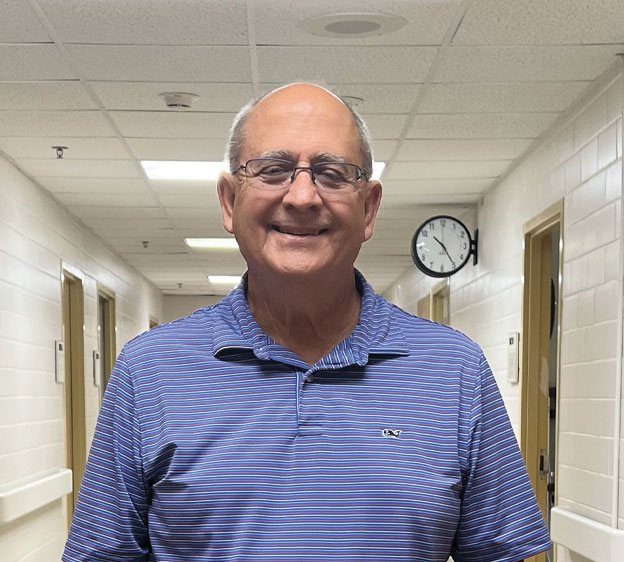Navy Veteran's Robotically Assisted Knee Replacement Journey
November 30, 2023Categories: Knee Replacement

In 2015, Hurricane Matthew tore into Beaufort taking out a lot of trees. Behind the scenes, the hurricane also took out Frederick “Fred” Schmidt’s right knee.
While prepping for the storm, the now 68-year-old orthopedic physician assistant missed a step in his garage and his knee — which had given him a bit of trouble for years — buckled, tearing his meniscus.
“After surgery to repair the tear, things were fine for a time,” he says. “But last July, my knee started getting worse.”
Being an ortho guy himself, the quiet-spoken Navy veteran initially chose to go the nonsurgical route with injections and physical therapy, but nothing helped. It was time to replace the knee.
I decided to phone a friend,” Frederick says.
Read More: When Is the Right Time to Have Knee Replacement Surgery?
Bringing in Backup
 That friend was Dr. Edward Blocker, a board-certified orthopedic surgeon with Beaufort Memorial Orthopaedic Specialists, who sees patients in Beaufort and Varnville.
That friend was Dr. Edward Blocker, a board-certified orthopedic surgeon with Beaufort Memorial Orthopaedic Specialists, who sees patients in Beaufort and Varnville.
“I had known Dr. Blocker for 10 or 12 years, and we had always gotten along well,” Frederick recalls. “In fact, after I retired from the Navy, we talked about the possibility of me joining his practice as a physician assistant, but the Navy wanted me to stay on in a civilian capacity. Since I’d been with them since 1977 when I started as a submarine corpsman, I decided to stay and practice at the Naval Hospital Beaufort.”
But when it came time to replace the knee, it was a given that Dr. Blocker was his first choice. “I knew he had been doing the Mako SmartRobotics™ knee replacement surgeries for a few years with successful outcomes,” says Frederick.
“In Fred’s case, as an orthopedic practitioner himself, he knew all of the appropriate conservative measures and had tried everything prior to seeing me," says Dr. Blocker. "His X-rays confirmed that his arthritis had progressed quite a bit in a short period of time."
The cutting-edge Mako robotic arm-assisted surgery system was one of the first orthopedic robotic systems to be widely used. It allows the surgeon to use the robotic arm to implant the components with greater precision, leading to better function and more natural movement.
According to Dr. Blocker, the first step in the Mako total knee replacement system is a patient-specific surgical plan. A CT (computed tomography) scan is taken of the knee to create a 3D virtual model of the patient’s unique joint.
“I use the model to evaluate bone structure, disease severity, joint alignment and the surrounding bone and tissue to determine the optimal size, placement and alignment of the implant,” says Dr. Blocker. “It’s important to understand that the robot does not perform the surgery, make decisions on its own or move without the surgeon guiding the robotic arm,” he adds.
Read More: From OR to RV: Enjoying Life After Knee Replacement
Going Home the Same Day
 During the operation, the surgeon follows the preoperative plan, guiding the robotic arm to remove arthritic bone and cartilage and position the prosthetic joint. A virtual boundary established by the robot prevents the surgeon from crossing the bone field into the surrounding tissue.
During the operation, the surgeon follows the preoperative plan, guiding the robotic arm to remove arthritic bone and cartilage and position the prosthetic joint. A virtual boundary established by the robot prevents the surgeon from crossing the bone field into the surrounding tissue.
“There is less irritation of the soft tissue, which can translate to less pain,” says Dr. Blocker.
“The fact that robotics technology allows for less invasive surgeries and faster recovery times was attractive to me,” says Frederick. “I’m a pretty active guy, so I went with it.”
According to Frederick, his knee replacement surgery in January went very well. He didn’t even have to spend the night in the hospital.
“The ward nurses got me up and moving with a walker and a few hours later I went home,” he says.
As is common, when the pain block wore off the next day, Frederick was in some discomfort. “But they gave me a prescription and I was much better the next day,” he recalls. “What was really helpful was the therapist who came to the house. He helped me quite a bit to keep moving and to stay motivated. It can be a little bit discouraging in the beginning, but it gets better quickly with regular physical therapy.”
Read More: John Aust: On the Go Again After Double Knee Replacement
Good Outcomes
A personalized rehabilitation program is an important part of the recovery process, according to Dr. Blocker.
“It can’t be overemphasized the importance of therapy after surgery to get the knee range of motion the best it can be, as well as restore the mobility and function that may have been lost when joint pain limited what you could do,” he says.
In addition, therapy helps build strength and endurance so patients can get back to their normal activity level more quickly.
“But nothing, not even a robot, can take the place of patient motivation and participation in their postoperative recovery,” says Dr. Blocker. “And Fred exemplified this.”
Just months after his surgery, Frederick was back on his bike and his club gym elliptical and in the pool doing water aerobics.
“I had a good outcome, and I’m still improving,” he says. “I have the highest regard for Dr. Blocker and his team. They did an excellent job. My experience at Beaufort Memorial was great, too. They took really good care of me.”
Ready to find lasting relief for your joint pain? Watch our Solving Hip and Knee Pain seminar or request an appointment with an orthopedic specialist.
